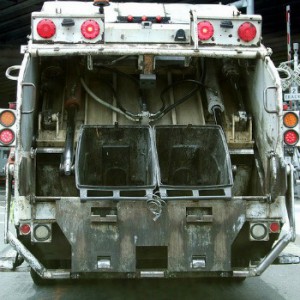
Waste Management In Ireland – Trends, Progress and Risks
29 Apr 2015Key Point
Ireland’s waste management has improved greatly over the last two decades. 92 per cent of its municipal waste went to landfill in 1995. This reduced to 42 per cent in 2013. EU waste policy has been central in bringing about this change. However, despite much progress Ireland faces challenges in meeting EU waste targets for End-of-Life Vehicles (ELVs) and Biodegradable Municipal Waste (BMW).
Background
Initiatives underpinned by the polluter pays principle, double dividend taxes and waste minimisation practices continue to influence EU waste policy. Waste treatment in the EU has been progressively improving over the last decade, as Member States work to meet targets set under EU regulations. Environmental policy has sought to decouple waste generated from economic growth. Since the introduction of the Waste Statistics Regulation in 2002, Member States have been obliged to monitor and report on the life cycle of waste in their jurisdiction. Figure 1 indicates progress made in the EU 27 between 1995 to 2013 in decreasing the amount of municipal waste sent to landfill (-49 per cent), as well as the large increase in recycling (+ 163 per cent).
Figure 1 – Municipal waste landfilled, incinerated, recycled and composted in the EU-27
(Source: Eurostat)
Eurostat figures detail the amount of municipal waste generated per person in the EU-28 in 2013. Irish people produced 586 kg of waste per person, which is 22% above the EU average of 481 kg per person. In comparison with the EU average of 28%, Ireland now recycles just over a third (34%) of municipal waste. However, Ireland still sends 42% of municipal waste to landfill, while composting accounts for 6%, and incineration 18%.
The municipal waste generated by country (kg per capita) between 2003 and 2013 are shown in table 1. The variations in municipal waste generated per person over the decade highlight consumption patterns among European populations. Ireland decreased per capita waste by a fifth; the sixth highest reduction.
Table 1 – Municipal waste generated by country in 2003 and 2013, (kg per capita)
Environmental Taxes in Ireland
Environmental taxes have played a key role in driving progress in relation to waste management. The Irish landfill levy was introduced in 2002 at a rate of 15 euro per tonne of waste. Since July 2013, it has been set at 75 euro per tonne of waste; an increase of 60 euro over the period from 2002 to 2013. The sharpest increase in price occurred in 2011 when the levy went from 30 euro to 50 euro. The plastic bag levy – introduced in 2002 at a rate of 15 cent per bag – was increased to 22 cent per bag in 2007. The Environment Fund, established in 2001, comprises revenue generated from the plastic bag levy and the landfill levy. The Fund is used to encourage environmental awareness of waste management sustainability, recycling practices and education, amongst other initiatives.
Figure 2 – Environment Fund Revenue 2001 – 2013

(Source: Environment Fund Accounts, DECLG)
Of the €58 million directed into the Fund in 2013, €43.3 million came from the landfill levy and €14.7 million from the plastic bag levy. Since 2001, the Environment Fund has accumulated over half a billion in revenue up to 2013 (€633.6 million).
EU Directives
Ireland has failed to meet EU waste regulations in the past. In a landmark case in April 2005, the European Court of Justice (ECJ) ruled that Ireland had contravened the Waste Framework Directive persistently under a number of articles1 . Challenges remain for Ireland over the coming years in meeting EU waste recovery targets and avoiding costly financial penalties 2. Table 2 below highlights the challenge Ireland has faced in meeting End-of-Life Vehicle (ELV) targets set for 2006, as they were not achieved until 2012. Likewise, there is a risk that reuse/recovery and reuse/recycling targets for ELV for January 2015 were not met.
Table 2 – End-of-Life Vehicle Directive Targets in Ireland

(Source: EPA (2014) National Statistics *based on 2012 data; most recent data sent to European Commission)
Furthermore, in relation to municipal waste, the EPA has stated that there is a risk that Ireland may not meet the strict targets set for diversion of biodegradable municipal waste (BMW) from landfill by 2016. However, as shown in Table 3, Ireland did meet the BMW target for 2010, and preliminary data for 2013 suggest the 2013 target has also been met. Ireland received a derogation of four years on both of these targets.
Table 3 – Landfill Directive Targets in Ireland
Strict landfill licensing to limit the acceptance of biodegradable municipal waste, further extension of provision of brown bins to households, and additional increases in the landfill levy may be required to achieve targets beyond 2016.
Notes:
1 Department of the Environment, Community and Local Government (2014) – The Government continues to update its progress on measures it has and will take to satisfy the judgement made against it in Case C494/01.
2 The cost incurred by the State in addressing the issues identified in the ECJ ruling, up to November 2014, was estimated to be €159 million.
3 BMW going to landfills must be reduced to 75% of the total quantity (by weight) BMW produced in 1995
4 BMW going to landfills must be reduced to 50% of the total quantity (by weight) BMW produced in 1995
5 BMW going to landfills must be reduced to 35% of the total quantity (by weight) BMW produced in 1995





